MAP READING AND MAP INERPRETATION
The Concept of Map and its Importance to Social Economic Activities
Explain the concept of map and its importance to social economic activities
Map
reading is the process of identifying features on a map by using
symbols and signs or names. This technical work requires certain skills
that any map reader must possess.
Map
interpretation refers to interpretation of the symbols and signs used
on map into ordinary language by indicating the features they represent
and draw logical conclusions from the information as represented by the
symbols.
Importance of map reading
Map
reading is very important to social and economic activities. Maps are
drawn for different purposes and once drawn they can serve as databases
from which various information can be obtained and used for a myriad of
social and economic benefits.
- Geological maps provide information about the type and distribution of rocks in an area. This knowledge is of great help to builders who can use it to find out where to obtain certain rocks for construction. This knowledge can also be used by mineral prospectors to locate possible areas where they can obtain mineral. The information on soil types can be used by civil engineers to establish the stability of the on which to build roads and other structures.
- Relief maps provide information to many people in many ways. For example, civil and architectural engineers need to know relief of an area so that they can plan in advance how to overcome relief barriers in their construction plans. It also important to large scale farmers as they need relief to plan for the extent of farms and also to determine the possibility of mechanization (use various machines in agricultural production).
- Drainage maps are useful to civil engineers as they can use them to get prior knowledge on how to construct bridges, roads, railways and other infrastructures. It is also useful to agriculture as such maps indicate possible sources of water for irrigation of crops, watering livestock and for other general farm uses.Weather and climate maps are useful especially to people interested in agriculture. They provide information on the kind of crops to be grown and the type of livestock to keep in a certain area.
- Vegetation maps show the distribution and type of vegetation in a region. This gives a clue on the kind of social and economic activities that can be carried out in an area.
- Soil maps are very useful to agricultural officers as they can use the information about soil types to advise farmers on the type of fertilizers to use, soil requirements and proper soil management practices.
- Maps provide information on the relationship between phenomena or events. For example, maps showing the location of volcanoes also indicate the connection between volcanoes and earthquakes. Earthquakes are very common in areas with numerous volcanoes. This will give people crucial information on the possibility of occurring vulcanicity so that they can avoid setting settlements on such hazardous areas.
- Maps provide background information as compared to present work. For example, maps showing distribution of forests in the past may be compared to the present maps to draw conclusion on the extent of vegetation change through deforestation, afforestation or reforestation.
- Maps provide valuable information for statistical analysis. Therefore, they are very useful to researchers and any field of study.
Essentials of a Map
Identify essentials of a map
Essentials
of a map are the necessary prerequisites that a map should have. All
maps in general require the following qualities or essentials:
- Title – The most basic component of a map is its title. The title should refer to everything the map covers. It could be a basic name of a country, such as "Tanzania," or it could be more extensive, such as "Water Tables in the Western Saharan Desert." The title should clearly state what the cartographer’s intentions and goals are; it should be specific, and it should not include irrelevant information.
- Scale – shows the relationship between map distance and ground distance. For example, the scale 1:100000, indicates that one centimetre on the map represents 100,000 cm (1 km) on the ground.There are three types of scales: (a) Statement scale – this is a map scale stated in words or it is a verbal scale. The words “one centimetre to one kilometre” is an example of a statement scale. (b) Representative fraction – this is a means of expressing the relative size of a map or drawing by a fraction or ratio e.g. or 1:100. This means that one unit on the map represents one hundred units on the ground. (c) Linear scale/graph scale – this is a line showing the distance on the map that represents a given distance on the ground. A linear scale is divided into two parts: Primary section – it is placed on the left-hand side of the linear scale. Secondary section – this is placed on the right-hand side of the linear scale.
- Key – every map must have a key. The key is a vital tool in understanding and interpreting the map. The key should explain every feature or symbol contained on the map. It should reveal what every marking means and sometimes provide additional information. For example, a city may be represented by a large black dot of a certain size on a map, and the key may explain that this represents a city with a population greater than one million people.
- Margin/boundary/frame – it is essential that all maps be enclosed in a frame for neatness.
- North direction/compass orientation – this is the direction towards the North in those maps drawn to grid system. All maps must have a compass orientation. Because the primary purpose of a map is to provide and insight into directions, a map has to be able to show which way is which on a compass. Most maps have "North" at the top and "South" at the bottom, but all maps should have an official representation of the compass orientation.
- Date – to give context to a map, the date of publication should be present. As maps are continually updated with additional information and improved accuracy, it is important to know the time when your map was published. For example, viewing a map of Tanzania published in 1980 might still be useful but will not be as accurate as one published in 2014.
Reading and Interpreting Topographical Maps
Information from Maps
Generate information from maps
Description of relief
It
is important to be specific when describing the relief of an area
represented on a map. The following steps should be followed:
- Provide a general description of the relief of the area. State clearly whether it is mountainous, hilly, a plateau, lowland, valley, etc. State the general altitude of the area by mentioning the possible lowest and highest points and their actual or approximate heights as well as their specific locations on the map. You can get this information from contour lines, spot heights or trigonometrical points. It is important to give as accurate height as possible.
- If distinct relief regions occur on a map, the area should be divided into distinct regions, e.g. highland, plateau, lowland, swampy area, etc. Each area should then be described in detail by mentioning the features present in the respective area. Describe the slopes and ranges in their heights, the nature of slopes, types of slopes, general direction of the slope and the landforms found in the area as well as their characteristics.
- Locate the relief or landform features present in the area and describe their distributions and locations on the map. These features can be located by using grid references, points of the compass or the nearest named places. In case of slopes, describe the type and direction of slope and comparative steepness or gentleness. Use the appropriate terms for describing types of slopes e.g. regular, convex, concave, gentle, etc.
VEGETATION
On
topographical maps, only selected types of vegetation are shown. These
are forests, thicket, bamboo, riverine trees (also known as galleric or
riverine forests), woodland, scrub, scattered trees, palms and swamp
vegetation.
The
specific swap plants such as mangrove trees, swap trees, marsh plants
and papyrus can be deduced from the type of swap shown on the map.
The symbols on the map that are used to represent various vegetation types are often interpreted in the map key.
Describing vegetation
When
describing natural vegetation on a topographical map, first identify
and name all types of vegetation shown on the map. Then describe each
vegetation type separately. Indicate the location of each type of
vegetation by using the grid reference or compass direction. For
example, one may state “There is a dense forest on the eastern area of
the map and mangrove trees along the river.”
If
some vegetation types are named on the map, e.g. “Nyandarua Forest”,
use the name given to locate the position and type of vegetation. The
area covered by particular vegetation should also be estimated and
given.
It
is important to find out the reason for the particular distribution.
These reasons are deduced from the information given on the map, which
is referred to as evidence. For example, an area with large permanent
rivers indicates that the area receives high rainfall. This may be the
reason for the existence of dense forests in the region.
DRAINAGE
Drainage
is the natural or artificial removal of surface and sub-surface water
from an area. Drainage also includes other features such as lakes,
swamps, canals, and ponds which are related to water. However, water
tanks and cattle dips are not features of drainage because these
features are built by people who also fill them with water. These
constructed drainage features are also called hydrographic features. Map
makers use blue as the conventional colour for water features.
Rivers and streams
These
are referred to as water courses in some maps. They are shown by blue
lines. The size of a river is indicated by the size of the blue line.
The thicker the line is, the bigger the river. The very thin lines
represent streams. The names of some rivers are written in blue print
along the lines representing the rivers.
Permanent
rivers are shown by continuous blue lines while the broken blue lines
represent intermittent (seasonal) rivers. If a river appears to abruptly
end somewhere on the land, it means that it disappears into the ground
at that point. This implies that at that point where it disappears then
rocks are probably very porous or are limestone type or there is a fault
line. Normally, a river ends in another river, a swamp, lake or sea.
Rapids and waterfalls, like river valleys, are relief features found
along a river course and are therefore not in the category of drainage
features.
The
symbols used to show them on small rivers are not the same as those
used on large rivers. These should be carefully studied. The presence of
waterfalls and rapids may indicate presence of alternating hard and
soft rock along the river.
They
may also imply presence of protruding resistant rock outcrops on the
river bed or sudden change in the slope of the river bed.
Lakes
A
lake is a body of water occupying a sizeable basin, depression or
hollow in the ground. It is bigger than a pond. A lake with no
indication of water flowing out of it is regarded as an area of inland
drainage.
Natural
lakes are shown using a light blue shade of stipples. Seasonal lakes
are indicated by a series of broken, blue, short lines with the word
“lake” written on them or by the name of the lake. Man-made lakes
(reservoirs) are shown by a dark blue tint behind a black line that cuts
across the river.
Sea
A
portion of an open sea is represented by a pale blue colour that is
shaded with stipples. Its coastline is indicated by a blue line.
Swamp
A
swamp is a wetland with its associated vegetation. Swamps are common
where the ground forms a shallow depression. There are various types of
swamps and they are shown by different symbols which can be identified
in the key. The different types of swamps shown on 1:50000 maps of East
Africa are:
- Mangrove swamps – these are found in the shallow parts of the sea shore, and around sea inlets.
- Tree swamps – water-logged areas that have a significant number of trees and some other smaller plants growing in them. There are some water-logged areas where trees are so many that they form a forest. Such a forest is called a swamp forest.
- Papyrus swamp – dominated by papyrus reeds. These are common on plateaus and lowlands.
- Marsh – an area that experiences temporary flooding, and the land is usually wet and poorly drained. It is characterized by plants such as rushes, reeds and sledges, with occasional water-tolerant trees. At the coast, where flooding is due to water, it is called a salt mash.
- Bog – spongy water-logged area with a surface layer of decaying vegetation. The papyrus swamp, marsh and bog are all shown by the same symbols on a 1:50000 scale topographical map of East Africa.
- Seasonal swamp – a very shallow basin and flat area of ground that become flooded during the rainy period for some months, but which dry up during the dry season. On a topographical map, they are shown by a group of broken blue lines.
Ponds, waterholes, boreholes, wells and springs
- A pond is a small mass of stagnant water that is commonly found along courses of small rivers. Most ponds are constructed by people but some occur naturally. They are shown as dark blue areas on topographical maps.
- A waterhole is a shallow and broad pit that traps rainwater. Some waterholes are natural while others are constructed by people to provide drinking water for livestock or wild animals. For coloured map sheets, the letters “WH” against a small blue circle is the common symbol for this feature. If an alternative symbol is used, it can easily be identified in the key.
- A borehole is a deep hole drilled in the ground for the purpose of obtaining underground water. The initials “BH” against a blue circle are used to represent it on a topographical map.
- A well is a hole, larger than a borehole, which is dug in the ground for obtaining underground water that is fairly close to the surface. This is shown by a blue circle and a letter “W” or letters “We” against it.
- A spring is a place where underground water flows out from the ground to the surface naturally. It is indicated by a blue circle and letter “S” or letters “Spr” against it. New editions of topographical maps may have these symbols modified.
Note:
These symbols are clearly indicated in the key of the map. It is
advisable to always study the key before proceeding to identify and
interpret the various symbols drawn on the map. Some modifications of
the symbols may be expected. So you should not get confused by cramming
the symbols off head.
Irrigation canals
An
irrigation canal is a channel that is dug in the ground for the purpose
of carrying water from a river, well or lake to a farm. On maps, they
are shown by blue lines that are usually written against them.
Ditches and drains
These
are trenches that are normally constructed in water-logged areas for
the purpose of draining water from the land. On a topographical map,
they are shown by straight blue lines with some of them having definite
angles. The ward “ditch” or “drain” may be written against the line.
Though
water tanks, cattle dips and wind pumps are connected with water, they
are not drainage features but are cultural features for saving water.
The presence of many permanent rivers, streams, lakes and swamps is an
indication of high amounts of rainfall received in the area. On the
contrary, if many of these features are seasonal, it implies that the
area receives low rainfall. Numerous waterholes, boreholes and
irrigation canals in an area may also be an indication that the area
receives low rainfall and that it experiences water shortage.
Description of drainage
When
describing drainage, one should first identify the various drainage
features and name them. Describe each feature in turn by describing the
distribution of that feature in the area represented and locate it on
the map. State the general quantity, volume or size of the feature and
describe the characteristics of each, for example, seasonal permanent,
big or small, etc. when describing rivers, it is important to comment on
the stream density, general direction of flow of the rivers, the sizes
of rivers and stage of development, i.e., youthful, mature or old-age.
Identify river drainage patterns as well.
Information from Maps in Relation to Daily Activities
Interpret information in relation to daily activities
Human
(artificial) features on topographical maps reflect human activities
taking place in the area covered by the map. Many human activities are
in the form of “land use” which refers to the ways in which land is
utilized in the area. The human activities represented on topographical
maps include the following:
Agriculture
Agriculture
is the cultivation of crops and/or rearing of livestock. In modern
times, the term has been expanded to include fish farming, beekeeping
and poultry farming.
On
topographical maps, crop plantations are shown as light, green shading.
A letter indicating the name of the plantation crop may be printed over
the shade e.g. “S” for sisal, “Su” for sugarcane and “C” for coffee.
These symbols are also indicated in the key.
The
name of the crop could also be indicated by the plantation name e.g.,
Tungi Sisal Plantation. If the name of the crop is not indicated on the
plantation, it may be identified using other indicators on the map. For
example, the presence of a tea factory, coffee factory or decorticator
may imply the plantation crop is tea, coffee or cotton, respectively. In
the absence of any indicator of a crop that might be grown on the
plantation, there is a possibility that the plantation may be that of
trees, i.e., natural or planted forest. Small-scale farming activities
are not shown directly on the map. However, they may be deduced from
symbols, factories or stores. The presence of a tobacco processing
factory or tobacco store implies that tobacco is grown in the area. The
presence of flour mill or posho mill indicates that maize is grown in
the area.
A
ginnery implies that cotton is grown in the area. A cereals board may
imply that people in the area grow grain crops such as maize, millet,
wheat, etc.
Livestock
rearing is indicated by the presence of cattle dips, grazing grounds,
cattle markets, ranches,, stock holding grounds, waterholes, a water
tank in an isolated place, a slaughter house office or abattoir, a
butchery, veterinary office, dairy farm, creamery and dairy farming
schools, and many others. Any evidence that relates to livestock rearing
is enough to draw a conclusion about livestock farming.
Based
on the type of crops grown in an area, one can draw conclusion on the
type of climate experienced in that area. For example, tea and coffee
are usually grown on an area that experience high rainfall and with
moderate temperatures. Crops such as sisal, millet and cassava indicate
that the area receives low rainfall and experiences high temperatures.
Likewise,
the type of livestock kept in an area can be useful in making
conclusions about the climate of that area. Dairy farming indicates that
the area has cool climate and receives high amounts of rainfall. Beef
cattle farming, pastoralism, ranching and camel rearing all indicate
that an area receives low amounts of rainfall. This may be a clear
indication that the area experiences a dry climate.
Forestry
The
presence of forests and forest reserves on a map indicate that forestry
is practised. The presence of forestry can also be indicated by
features such as forestry training school, forest station, or forest
guard post. The presence of sawmills within or near a forest indicates
that lumbering may be taking place in the area.
Fishing
On
topographical maps, the presence of water body does not indicate the
presence of fishing activities. In conjunction with the presence of a
water body, we have to look for the following evidences to conclude,
beyond reasonable doubt, that fishing activities are taking place on the
water body shown on the map:
- The presence of the symbols of fish traps at the edge of a water body.
- The named places such as fishing village, fish ponds, and hatcheries near a water body. We can also look at the presence of Fisheries Departments, fish markets, Fishing Cooperative Society, a fish processing plant, etc.
Mining
Mining
activities are often indicated by a particular symbol that is included
in the key. Words such as “Gold Mine” may also be used to conclude that
mining activities are taking place in that particular area. Mining,
however, should not be confused with quarrying.
Quarrying
Quarrying
is the activity involving excavating stones, sand or soil from the
ground. A special symbol with the word “quarry” written against it is
used on topographical maps to indicate where quarrying is carried out.
This is different from mining and that is why both activities are shown
by different symbols.
Trading
This
is a commercial activity involving buying and selling of commodities.
On topographical maps, it is indicated by letters “TC” which are
initials for Trading Centre in areas where there are settlements. Other
evidences of trading include shops, markets and petrol stations.
Transportation
This
involves the movement of people, goods and animals from one place to
another. It is evidenced by the presence of transportation
infrastructures such as roads, railway lines, footpaths, tracks,
airports, seaports, pipelines, etc. The symbols representing these
structures are often provided in the key.
Communication
This
refers to the means of conveying or exchanging information. The
evidence of communication services and activities includes the presence
of a wireless station, post office (PO), telegram (Tg), telephone (T)
and telephone lines, and a satellite station.
Industries
These
are evidenced by the presence of manufacturing and processing factories
or industries in an area. They may be shown and named on maps. Examples
of industries include sisal and tea processing factories, coffee
pulping plant, floor or posho mill, bakery, creamery, cement factory,
motor vehicle assembly, fruit processing factory, sawmill, ginnery or
simply the word “factory” or its abbreviation “Fcty” are all evidences
of industrial activities.
Tourism
Tourism
may indicated by such features as camping site, hotel, recreational
grounds, game reserve, national park, museum, historical monument,
tourist resort, historical sites and nature reserve.
Administration
Various
administrative activities can be identified from abbreviations on the
map. These are given in a list in the margin of the map. They include
provision of security as evidenced by the presence of a Police Station
or Police Post, judicial services as evidenced by the presence of
courthouse, and other administrative offices such as District
Commissioner (DC) and Regional Commissioner (RC).
Other human activities
Besides
the activities described above, there are other activities that people
engage in on daily basis. These include teaching and provision of other
education services indicated by the presence of school, college,
university or training institution.
Health services are indicated by the presence of a hospital, dispensary, health centre or medical laboratory.
Religious
services are indicated by the presence of church, mosques or temple.
Recreational services are evidenced by the presence of golf clubs, golf
courses, stadium or other recreational grounds.
Description of human activities
When describing human activities in a given area on a topographical map, the following steps should be followed:
- Identify each activity and support it with evidence form the map.
- Describe the distribution of the activity in the area of the map using conventional methods.
- Give reasons, using available evidence, for the distribution of and factors that may appear to favour the activity.
INTERPRETATION OF SETTLEMENTS
A
settlement is a place where people dwell. On topographical maps,
settlements are depicted by dots or blocks, which may be black or grey
in colour. Dots are identified in the key as huts or houses. They
represent semi-permanent structures that are typical of rural
settlements in Africa.
Black
squares or rectangular blocks depict permanent buildings like those
built of stones or bricks and roofed with iron sheets or tiles. A
collection of these permanent buildings in one area is shown as a solid
block. This represents a town or an area with permanent buildings.
Description of settlements
Settlements are described based on their concentration or alignment. In terms of concentration, they may describe as follows:
- Dense – when there is a high concentration of individual blocks or dots in a given area.
- Moderate – when f individual blocks or dots are neither high nor low.
- Sparse – when individual blocks or dots are few and spread over a wide area.
On the basis of alignment, settlements can be described as follows:
Nucleated or clustered
In
this pattern, settlements are in groups or clusters. The reasons why
settlements are concentrated in a particular area include the following:
- A limited land for settlement.
- Security and defence – in rural areas people may need to live in groups for collective defence.
- Availability of social services such as educational, health, transport, and communication facilities
- Availability of economic opportunities like mining, trade, employment, etc.
- Conducive climatic conditions which favour a better living such as the absence of diseases or disease vectors such as tsetse flies, mosquitoes, etc.
- Fertile soils which favour agricultural activities.
- Government policies – the government’s land policies can also have a lasting effect on location of settlements. For certain reasons, the government can set up policies which prohibit establishment of settlements in particular areas.
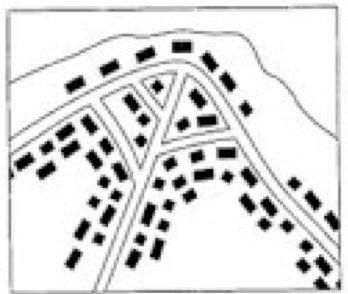
Nucleated settlement
Scattered or dispersed
In
this pattern, the settlements appear to be randomly dispersed over the
area. It is typical of rural areas where people own individual pieces of
land and set up their own dwellings anywhere on their lands. It can be
found in new settlement schemes. The distribution may be any of the
types discussed above. The factors behind this type of settlement
include the following:
- Readily available land for settlement without any restrictions.
- A fertile soil that attracts a large population. The land is sub-divided into small plots.
- Availability of water within easy reach by families.
- Generally reliable security over a wider area. There is therefore no need for group defence measures.
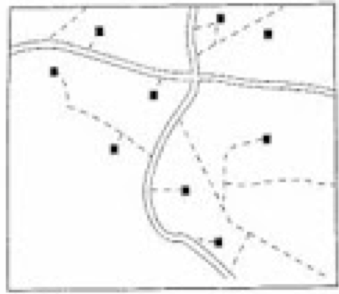
Scattered settlement
Linear
In
this pattern, settlements are set up in a line form along certain
features such as roads, railways, coastlines, etc. Some of the factors
leading to development of this pattern include:
- Presence of a road, motorable track or footpath for easy transport.
- Presence of a river that may provide water for domestic and commercial use.
- A coastline or shoreline that is favourable for fishing.
- Suitable terrain, e.g. the foot of an escarpment where the slope is gentle and where they may be scarp springs for water.
- Infrastructure planning like in plantations where settlements are set up in lines.
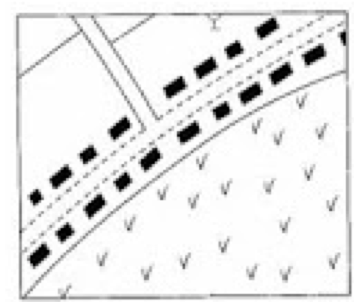
Linear settlement
Besides
describing the distribution of settlements in terms of the density and
patterns, the factors that influence their distribution should be
identified by examining the map carefully. Such factors include relief,
vegetation, drainage, transport and other economic activities as may be
found indicated on the map.
Note:The
description of settlement as dense, moderate or space is often termed
as forms of settlement and description as scattered, linear or nucleated
is termed as settlement patterns. So, one should not confuse the two
terms when referring to settlements.
PHOTOGRAPH READING AND INTERPREATION

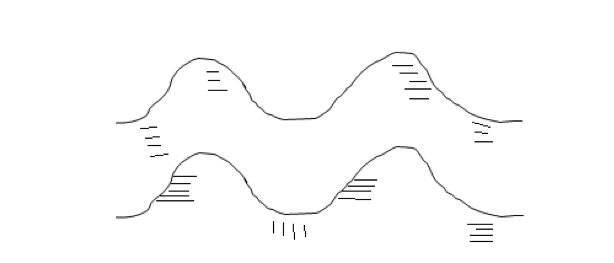

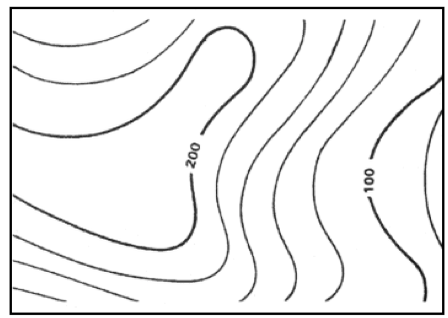
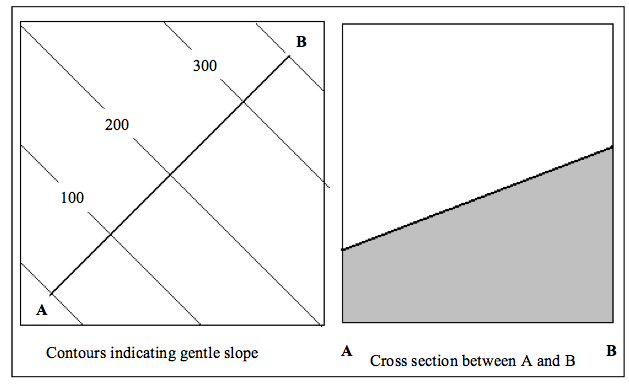
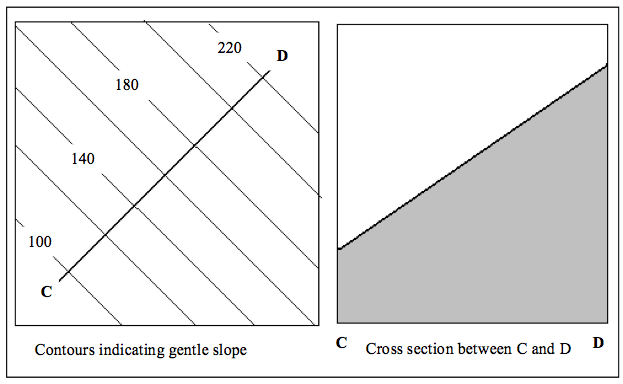
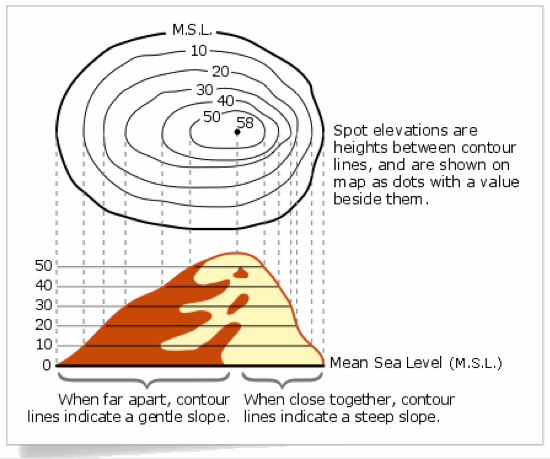

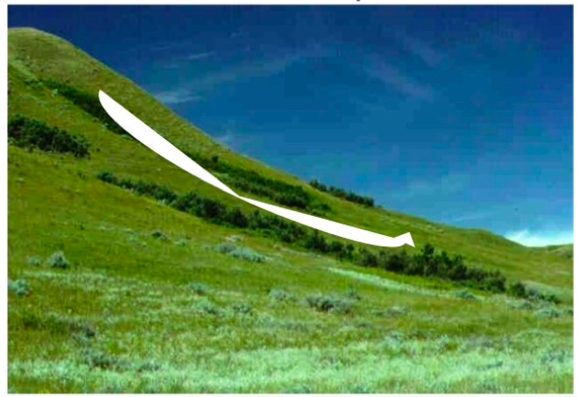
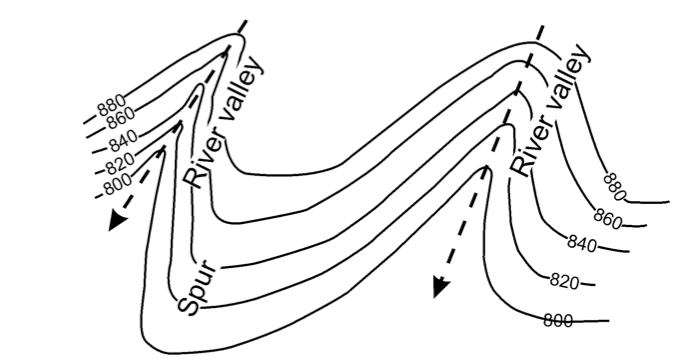
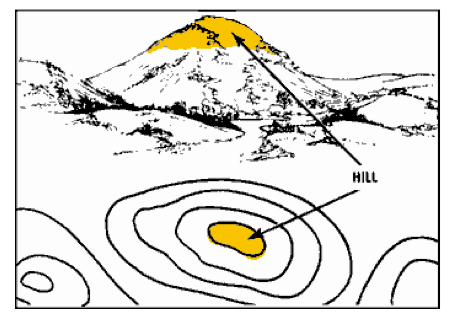
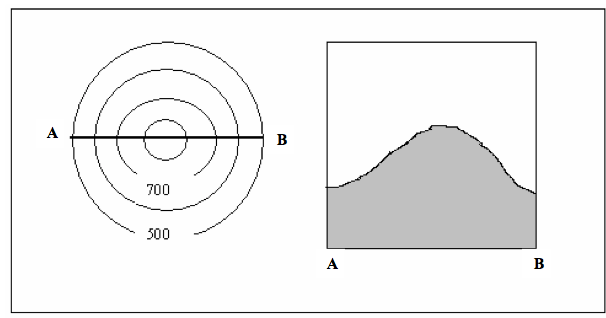
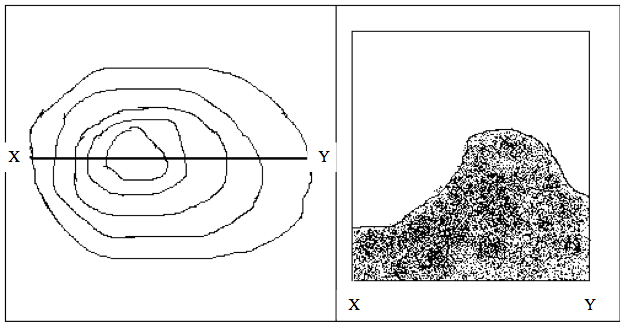
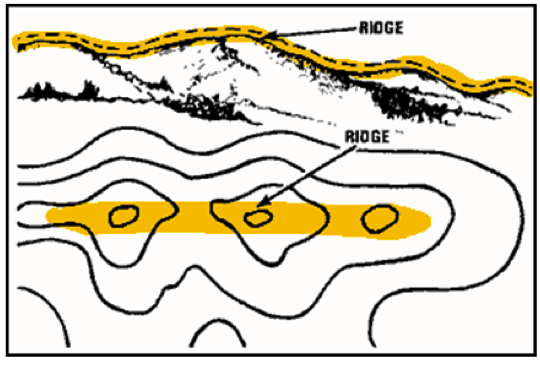



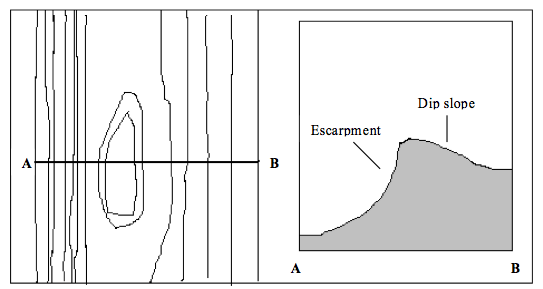
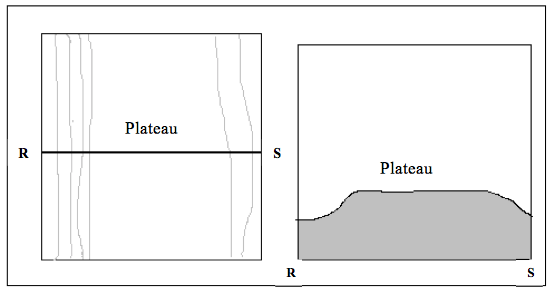
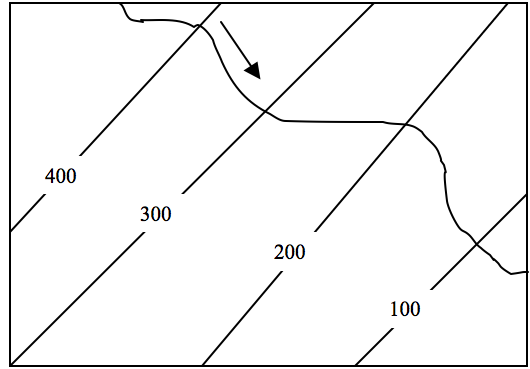
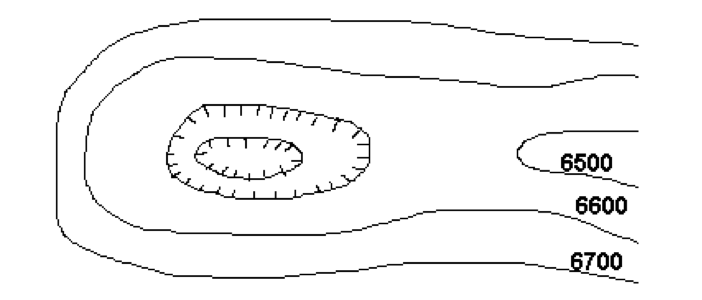

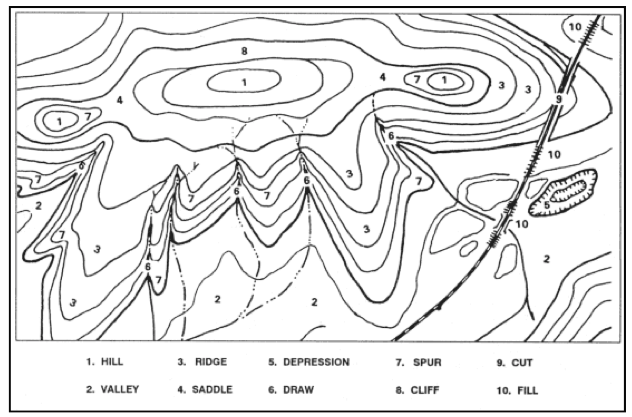
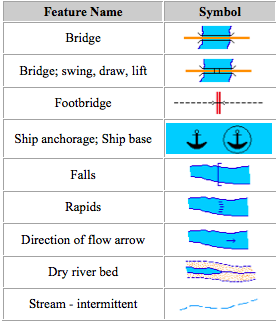
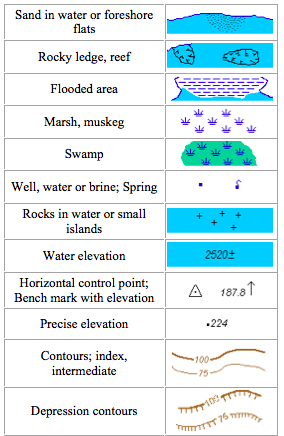
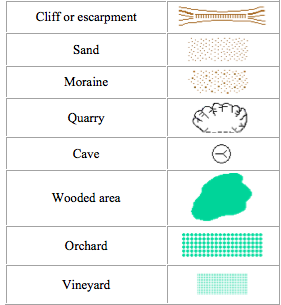
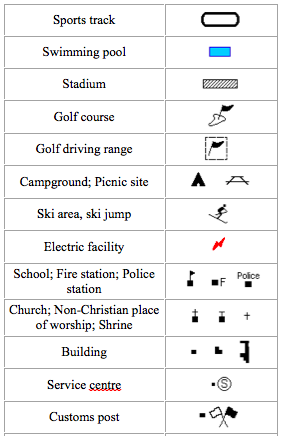




No comments